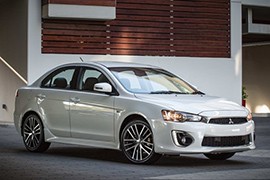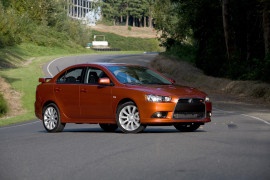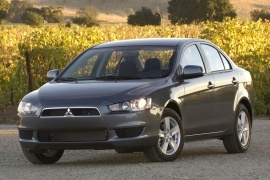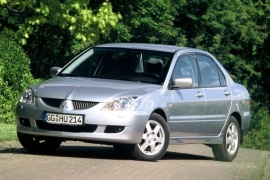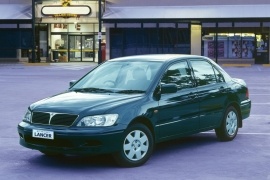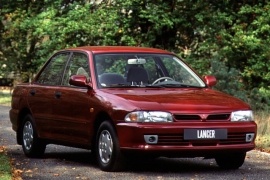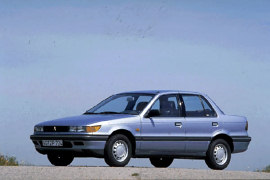MITSUBISHI Lancer Models/Series Timeline, Specifications & Photos
First production year: 1988
Engines: Gasoline, Diesel
After almost a decade since its first appearance on the market, the Lancer received a final facelift before it was completely changed in 2017.
When Mitsubishi introduced the Lancer in 2007, nobody thought that the carmaker would keep it into production for such a long time. But the struggling Japanese carmaker couldn't afford to change it. Its finances were hit hard during the world financial crisis, and its products were already old and difficult to sell. The Lancer was supposed to save the brand, but it just couldn't do it by itself.
For 2016, the Mitsubishi designers reshaped the front bumper and made it bigger, and included the LED daytime running lights on the outer side-pods. Unlike many other carmakers, they didn't install LED headlights since they were too expensive to implement. On its sides, the Lancer featured a new set of side-skirts.
Inside, the carmaker kept the same spartan look of the interior, but it installed an updated touchscreen infotainment system on top of the center stack. The binocular-style instrument cluster remained the same as before, with a TFT display between the tachometer and speedometer. For the sedan version, the Lancer featured a fixed, split-folding rear bench seatback.
Under the hood, the base version featured a naturally aspirated 2.0-liter engine that provided 148 hp. The other engine option was a 2.4-liter naturally aspirated unit that provided 20 ponies more. Both versions were paired as standard to a 5-speed manual while a CVT was on the options list.
Known as the motorsport division of Mitsubishi, Ralliart focused on the Lancer's ninth generation and offered it as a civilized version of the mighty Evo X.
Once, Mitsubishi was fighting for titles in the World Rally Championship with its Lancer Evolution models, but the Evo X was no longer in the position to win races. Yet, it was one of the preferred cars for rally fans.
The car's exterior was similar to the one provided by the Evolution X, but there were some differences between them. At the front, the Ralliart version featured a small red badge on the broad black grille. Unlike its X-sibling, it didn't feature a silver horizontal slat on the bumper area. From its sides, the differences between these two vehicles were even more obvious since the Ralliart didn't sport an exhaust vent behind the front fenders. Moreover, the rear fenders were normal, not enlarged like on its more powerful sibling. Finally, at the back, the wing mounted on the trunk didn't provide any adjustments or a refined, aerodynamic shape.
Inside, the cabin was designed mostly for comfortable yet sporty rides. There were no sports seats on the Ralliart, but the high-bolstered ones did provide adequate side support. In addition, the center console hosted the automatic transmission lever instead of the six-speed manual stick. Last but not least, the carmaker added paddle shifters behind the steering wheel.
Under the hood, Mitsubishi's motorsports department installed the same inline-four, turbocharged gasoline engine featured on the Evo X, but with fewer ponies. It was paired with a six-speed automatic (dual-clutch) gearbox that sent the power in all corners. Yet, the transmission was not as evolved as the one provided for the Evolution X. However, it still featured a rear limited-slip differential and an adaptive center diff.
Unveiled in 2007 at the Detroit Motor Show, the seventh generation of the Mitsubishi Lancer marked the first generation that was named Lancer all over the world.
The ninth generation of the Lancer was available in two body versions: three-box sedan and hatchback. Most of its fame came from the rally world, where the Lancer, along with the Subaru Impreza, were the last two cars that could meet the highest specifications of a Group N rally configuration. Apart from the hi-spec Lancer Evolution, the regular Lancer was available with other smaller, economical, engines.
The exterior look was fresh, with a big, trapezoidal, grille on the front and two angular headlights. The grille was extended into the front bumper. The angular shapes were extended on the bodywork up to the taillights. Depending on the engine and trim level, there were standard 16” steel wheels or 18” light-alloy wheels.
Inside, the dashboard was clean with two-round clusters on the dashboard. Depending on the option, an infotainment system with Bluetooth connectivity, a navigation system, and a USB aux was available. The firm, slim, front seats ensured good side support. The flat rear bench was good for two adults, but the transmission tunnel was obstructing the third passenger.
The Lancer was available with various engines starting with a 110 hp 1.5-liter naturally aspirated engine. Another 1.8-liter was available. Since the European customers asked for diesel engines, Mitsubishi installed a VW-supplied 2.0-liter TDI unit.
The 2003 Mitsubishi Lancer was still built on top of the Mirage platform but was aimed at those customers who looked for a compact-sized sedan.
Since it started to win races with the Lancer Evolution, the Lancer nameplate became more famous than the Mirage. That convinced the Japanese manufacturer to create a new lineup based on a new platform. With the seventh generation, that started to happen, and the 2003 model is the main proof of that. Unfortunately for the carmaker, it couldn't use the Lancer nameplate in Europe, so it had to use the Carisma instead, and it produced the car in the NedCar facility in the Netherlands.
The seventh generation of the Lancer featured triangular headlights with curved lines, following the new-edge design trend. Its mesh grille was adorned by a center vertical slat that supported the three-diamond badge. The apron sported additional cooling areas on the lower bumper: one wider in the middle and two side scoops. Its three-box sedan design was not that daring. However, it offered body-colored door mirrors and handles, while other carmakers still used the same black, unpainted details.
Inside, the dashboard was a mix of black, gray, and silver trims. Apart from the air vents and the radio, everything else sported rounded shapes. On the center stack, the carmaker decided to place the stereo above the HVAC control unit, which was a good idea, especially since there were no buttons on the steering wheel. Thanks to the larger wheelbase than on the sixth generation, there was more legroom for the rear passengers.
Apart from the Lancer Evolution, all other versions were powered by simpler engines. Depending on the market, the base version was put in motion by a 1.3-liter powerplant. Also, for selected versions, the carmaker offered a four-speed automatic transmission or a CVT.
MITSUBISHI Lancer 1.3L 5MT FWD (82 HP)
MITSUBISHI Lancer 1.5L 5MT FWD (90 HP)
MITSUBISHI Lancer 1.5L CVT AWD (90 HP)
MITSUBISHI Lancer 1.5L CVT FWD (90 HP)
MITSUBISHI Lancer 1.6L 4AT FWD (98 HP)
MITSUBISHI Lancer 1.6L 5MT FWD (108 HP)
MITSUBISHI Lancer 1.6L 5MT FWD (98 HP)
MITSUBISHI Lancer 1.8L CVT FWD (114 HP)
MITSUBISHI Lancer 2.0L 4AT FWD (114 HP)
Mitsubishi introduced the sixth generation of the Lancer in 2000, and, besides the ferocious, rally-inspired Evo VI, it also produced a more civilized four-door sedan.
It was the last Lancer based on the same platform with the Mirage. But it had almost no technical connection with the Lancer Evolution, which was built on a different platform. Still, the name was known, and after all, it was a decent sedan that had plenty to offer for a regular family.
The exterior was not Mitsubishi's strongest point, although the big, squared, horizontal headlights looked better and offered more light than on the previous generation. A slightly ascending hood and paved the way to the greenhouse. The carmaker installed a set of taillights that looked too small for the car's size in the back.
Inside, Mitsubishi was not very concerned about high-quality materials and the best finishes in its class. That said, the plastics were of poor quality, and the carmaker left some room for improvement in the fittings department. It offered adequate room for three adults in the back and good for the front ones on the plus side. Depending on the engine and trim level, the Lancer offered power-windows and locks, air-conditioning, and ABS.
Under the hood, Mitsubishi installed only two engines with different settings, ranged between 90 hp and 130 hp. For selected markets, it paired them with an automatic (CVT) transmission and all-wheel-drive.
In 1994, Mitsubishi introduced a sedan version for the Mirage lineup and named it Lancer for specific markets.
Every successful story has a beginning, and the modest-looking Lancer was the base for the future rally-racer named Lancer Evolution. In fact, the 1994 Lancer offered a version named GSR, which was punchy enough to stir emotions in a parking lot among a few car enthusiasts, but not too much to attract more people.
The car's look was, somehow, bland. Its rounded shapes from the bio-design era were not very clear, like if the design team was not very sure that they had to do that. At the front, the narrow headlights and grille were on the same page with other Japanese carmakers such as the Honda Civic or the Toyota Corolla. The low beltline and tall greenhouse, related to the overall height, was more conventional, like a 1990 Escort.
Inside, the Lancer featured a simple cloth upholstery, but like most Japanese cars from that era, it came well equipped. The power windows and locks and the AC were fitted as standard. In the instrument panel, Mitsubishi installed a center speedometer flanked on the left by the tachometer and on the right by the fuel and coolant temperature gauges, stacked one on top of the other.
Under the hood, apart from the GSR version, the regular Lancer provided similar engines as its Mirage sibling. The base version featured a 1.3-liter engine, while the top version had a 1.8-liter, fuel-injected engine.
Mitsubishi introduced the third generation of the Lancer, which was also the last built on top of the same platform as the small-sized Mirage lineup.
By 1988, the small-sized Mirage hatchback was known in the U.S. as the Colt or, under American branding, Eagle Summit or even Plymouth Colt. It was a mass-market vehicle that served well for many. Still, its three-box sedan version, the Lancer, was on its way to becoming even more famous. But not yet, though.
The front fascia resembled the same look as its hatchback sibling, with a narrow grille flanked by wide headlights and underlined by the black trim from the bumper. However, its corner-mounted turn signals offered a unique styling design, with an ascending look for its rear edges. On the apron, Mitsubishi made room for pair of small scoops and a larger, lower mounted grille. However, the car's not that appealing styling was somehow saved by the greenhouse's shape that ended with an abrupt, almost vertical rear windscreen. Moreover, the flush door handles were a rare feature for the car's price segment and size.
Mitsubishi struggled to offer a decent interior for this econobox and installed a steering column adjustable for height and reach, which was unusual for those times, even in larger vehicles. The short wheelbase led to limited legroom for the rear passengers, but still, two adults could have been accommodated there. Moreover, this sedan featured a split-folding bench!
The car's underpinnings were obviously shared with the Colt, and its engine lineup differed depending on the market. It was not yet, time to become the famous Lancer Evo that stormed the World Rally Championship. But was on the right path.
